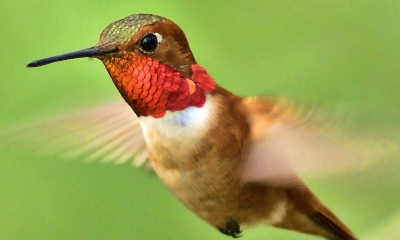
Hummingbirds
Oregon has seven hummingbird species that make for great backyard bird watching.

Types of Hummingbirds

Noteworthy as a generalist, the Black-chinned hummingbird appears in a wide variety of habitats, including lush river bottoms, urban settings and desert canyons. Below the male's velvety black gorget is an iridescent purple band that can also look black in poor light. At rest, the wingtips are relatively broad and curved, unlike any other North American hummingbird.
A rare to locally common resident east of the Cascades, it is least common in Klamath and Lake counties. Summer habitat in eastern Oregon includes canyons, juniper woodlands, and desert riparian zones. In the foothills of the Blue and Wallowa Mountains, it's found along stream bottoms and gulches. It also inhabits oak and scrub areas, open woodlands and towns.
Hear the call of the Black-chinned hummingbird
Photo by Charlotte Ganskopp
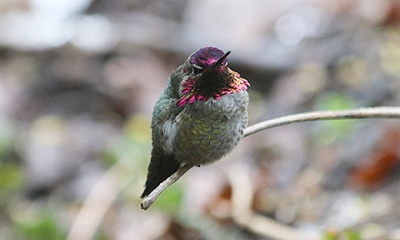
Anna's hummingbird is the largest hummingbird common to our region. It is the only hummingbird regularly found in Oregon in winter, during which time it is exposed to short day lengths, limited sources of food and periods of intense cold.
It is more vocal than most hummingbirds with males uttering a dry, scratchy buzz of a song that can be heard throughout the year.
It is a rare to locally uncommon summer resident west of the Cascades in interior valleys and along the coast; also along the Columbia River east to The Dalles. It occurs and probably breeds into the west Cascades at some urban developments such as Oakridge. In winter, it is uncommon to fairly common in western Oregon at lower elevations, especially where feeders are present. It is a casual winter visitor in the south Cascades.
Hear the call of the Anna's hummingbird
Photo by Michelle Dennehy, ODFW

The Costa's hummingbird is a very rare spring and summer visitant to central and southwestern Oregon. Males are sometimes present for the entire year in the Rogue Valley. Males have been observed in canopy-free riparian habitat along Bear Creek and semi-open tall white oaks at the edge of Agate Lake.
Many of these birds go undetected in Oregon because of their similarity with other hummingbird species.
Hear the call of the Costa's hummingbird
Photo by Mick Thompson, Flickr
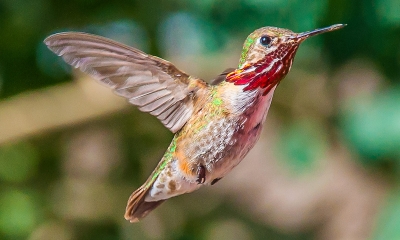
This tiny jewel is the smallest breeding bird in North America and the smallest long-distance avian migrant in the world. The average weight of males is approximately 0.09 oz, about half of that of an Anna's hummingbird, and a little more than the weight of a penny.
It breeds predominantly in mountain habitats, and despite its diminutive size, successfully withstands the chilly summer nights at high elevations. It is a common summer resident of the Blue and Wallowa Mountains and other high ranges east of the Cascade summit. Spring and fall migrants are rare at lower elevations east of the Cascades.
Hear the call of the Calliope hummingbird
Photo by Cinthea Fox, Flickr
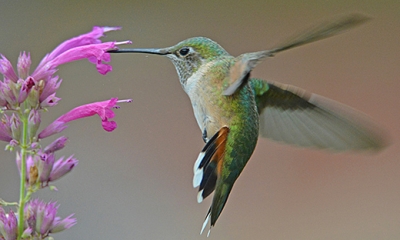
Perhaps the most enigmatic hummingbird found regularly in Oregon, the Broad-tailed hummingbird has so far eluded documentation of its breeding in the state, likely due to identification uncertainties and the remoteness of its preferred habitat.
Primarily a Rocky Mountain species, its hard-to-define breeding range seems to reach its limit at Oregon's eastern edges where reports of this beautiful and rare species arise each summer.
The relatively large adult male has a rose-red gorget and green plumage with no dorsal Rufous coloration. Females and immatures are nearly indistinguishable in the field from those of the more common Rufous hummingbird.
Hear the call of the Broad-tailed hummingbird
Photo by Chuck Roberts, Flickr

The Rufous hummingbird is the most common and widespread of Oregon hummingbirds. This rusty-red and fearless nectar feeder is a popular yard bird, inspiring even the most modest of nature lovers to set up a feeder.
It is a common transient and breeder throughout most of western Oregon, especially in forested regions.
Hear the call of the Rufous hummingbird
Photo by Charlotte Ganskopp
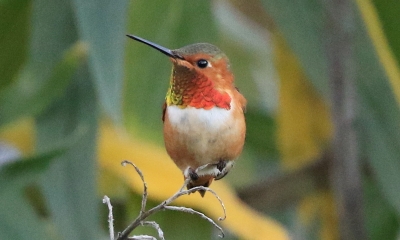
Allen's hummingbird is a common breeder in the coastal fog belt from California into southern Oregon. It is closely related to the more wide-ranging Rufous hummingbird with only subtle differences in plumage, behavior, and vocalization.
This is a fairly common spring and summer resident along the southern Oregon coast as far north as Bandon. It occurs as a very rare vagrant in other parts of western Oregon.
Hear the call of the Allen's hummingbird
Photo by Trish Gussler, Flickr

